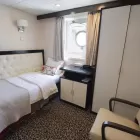In the evening, the ship approaches and docks in St. John's, North America's easternmost point. For centuries, the strategically good location attracted adventurers, traders, pirates and, not least, seafarers, who created the foundation for the city's prosperity. In 1497, Italian seafarers and explorers Giovanni Caboto (also known as John Cabot) came and proclaimed the enclave to the first permanent settlement in North America. Overnight, the ships stay at the quay and you can spend the next day in town.
St. John's oozes charm. In addition to the long, picturesque history, the city offers unique architecture and cultural and nature experiences. In the narrow streets of the town center, there are a wealth of museums, galleries, historic buildings, parks, restaurants, pubs, and cozy shops. St. John’s downtown is one of the oldest trading places in North America. One of the city's main sights is Signal Hill with beautiful views of the old historic harbor town. Already in 1704, flags were hoisted on Signal Hill when ships approached - be it kind or hostile. And for centuries, the vantage point was a sore point in military disputes.
Another attraction in St. John's is Cape Spear. In Newfoundland folklore, Cape Spear is also called "the western world of the far east", and right here you are at North America's farthest point. In addition to a stunning landscape, Newfoundland's oldest lighthouse is also located here.



























